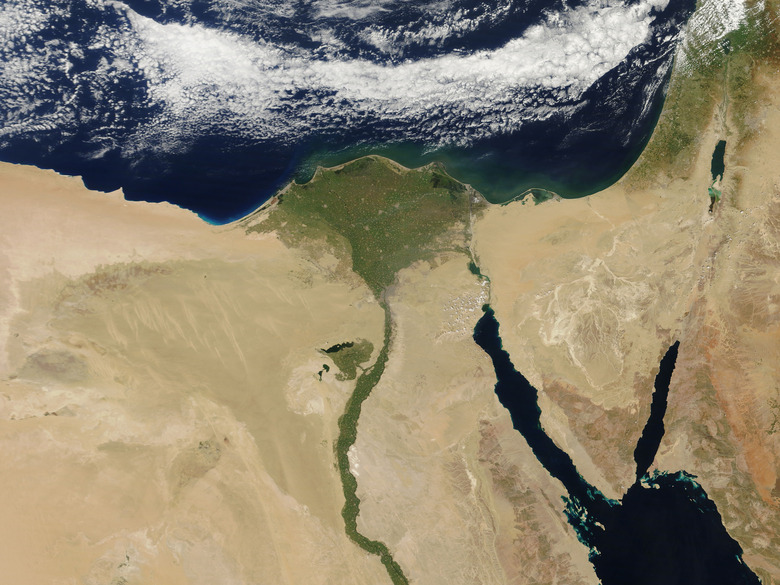What Is A Delta Land Form?
The term delta comes from ancient Greek. In the fifth century B.C., Herodotus used the term to describe the Nile Delta in Egypt, as it had a similar triangular shape to the Greek letter delta. Delta land forms are created at or near the mouths of rivers. Erosional landforms of rivers, deltas are caused by sediment, typically silt, that is eroded into a river and carried to its mouth, where the sediment is deposited. Common in small lakes, deltas usually form in places where rivers meet a calm body of water. Rich in nutrients and with fertile soil for agriculture, many modern societies developed around famous deltas and rivers.
Deposit of Alluvial Sediment
Deposit of Alluvial Sediment
Alluvial sediment is a term for material, typically silt (but also sand, gravel or other material), that is deposited on a land form by water action. As a stream approaches its mouth it becomes wider, and the current moves slower. This slowing of the current allows for the deposit of alluvial sediment and the creation of landforms such as deltas and alluvial fans.
Of course, the water body that the sediment is deposited in must be calm, or the sediment will be carried away from the mouth of the river or stream quickly. Alluvial sediment is particularly abundant in the runoff from a flood.
Formation of Deltas
Formation of Deltas
There are two types of actions created by stream systems: erosion and deposition. Delta land forms are created by both actions working together. Alluvial sediments are eroded upstream and carried down to the stream's mouth, where they are deposited.
Water velocity is slowed near a river's mouth when it enters a level plain, especially in a large river. The slow velocity causes sediment to settle and create sediment beds. When the sediment is excessive, such as during flooding episodes, the material will clog the flow of water and eventually create accumulation, which will become a delta over the course of time.
Alluvial Fans on Land
Alluvial Fans on Land
Alluvial fans are a form of delta where the alluvial sediment is deposited onto level land or a plain. These forms are similar to deltas but different in an important way. They are distinct in that deltas are formed in a body of water, and an alluvial fan is created on land.
However, the principle of sedimentation and the process of land form creation is similar. Deltas and alluvial fans can be thought of as two variants of the same type of land form.
Upper and Lower Delta Plains
Upper and Lower Delta Plains
Delta land forms are divided into upper and lower plains. An upper delta plain consists of lagoons, bogs, floodplains and braided stream channels. Lacustrine wetlands and marshes are also commonly formed in upper deltas. Typically, the soil in an upper delta is very rich, but the area is also prone to flooding.
The lower delta plain is located within the tidal zone and forms a brackish (saltwater) environment. Salt marshes are a lower delta plain land form.
Famous Deltas & Rivers
Famous Deltas & Rivers
Major deltas are formed at the mouths of the world's largest rivers, such as the Yellow River in China, the Nile in Egypt, the Amazon in South America and the Mississippi River in the United States. Culturally, the most famous delta in the world is the Nile Delta in Egypt, in the cradle of ancient Egyptian civilization.
According to scientists, the Mississippi Delta drains 40 percent of the continental United States and deposits an estimated 159 million tons of sediment annually. An even more impressive land form, the Huang He (Yellow River) Delta deposits 1.6 billion tons of sediment annually.
Unique land forms that are part of the interconnected network of waterways that weave around the surface of the planet, deltas are rich in resources and history.
References
Cite This Article
MLA
Peterson, John. "What Is A Delta Land Form?" sciencing.com, https://www.sciencing.com/delta-land-form-6505901/. 30 September 2021.
APA
Peterson, John. (2021, September 30). What Is A Delta Land Form?. sciencing.com. Retrieved from https://www.sciencing.com/delta-land-form-6505901/
Chicago
Peterson, John. What Is A Delta Land Form? last modified March 24, 2022. https://www.sciencing.com/delta-land-form-6505901/
